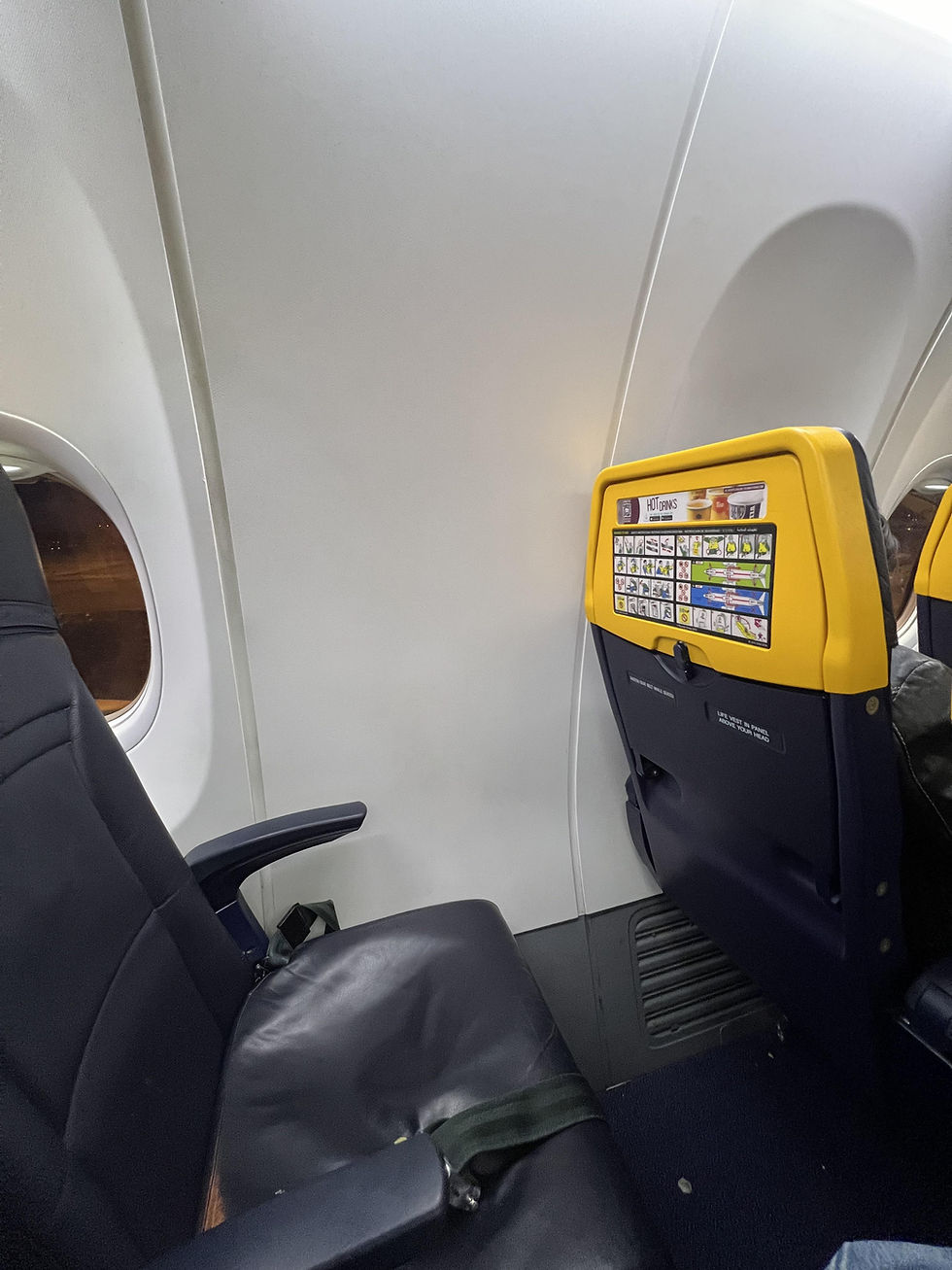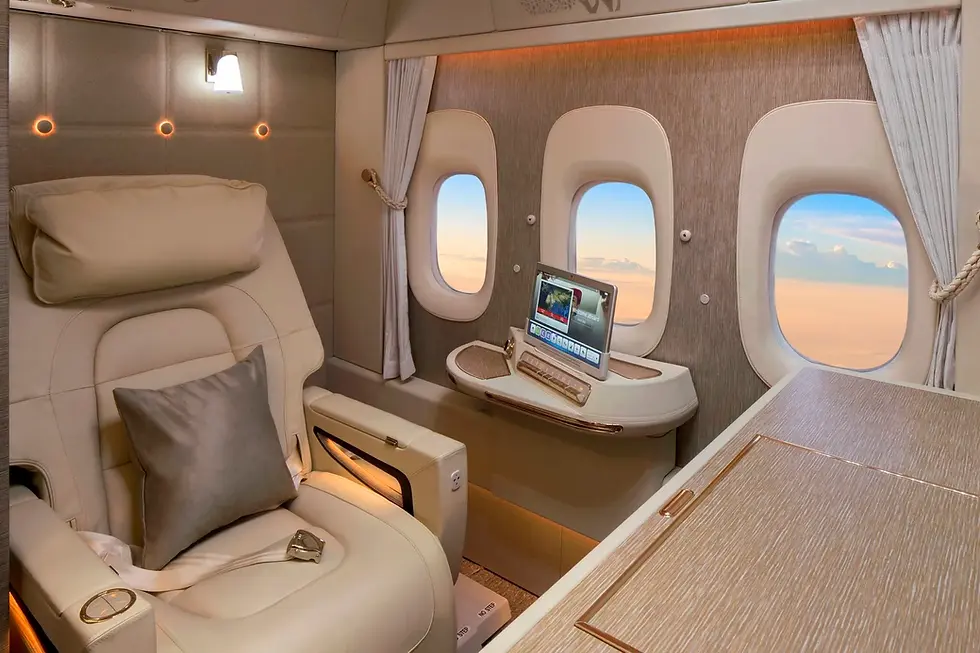You've Got a Window Seat on a Plane with No Window: Why It Happens and How to Prevent It
- Sam

- Sep 26
- 5 min read
This is the situation. You've specifically selected a window seat for your flight, excited to watch the world shrink below you as you take off or catch a glimpse of your destination from above. You board the plane, find your row, and discover... a blank wall where the window should be. Welcome to the frustrating world of the windowless window seat.

Spend any amount of time online and invariably you will find countless complaints from people who have been duped into a window seat on a plane with no window: here's why is happens, and how to prevent it.
I will admit that this post was inspired by Ryanair, more specifically the press team who control their Twitter and TikTok, endlessly sassing customers for my enjoyment.
Why Do Windowless Window Seats Exist?
Aircraft manufacturers don't randomly decide to skip windows out of spite for passengers. There are several practical reasons why some "window" seats lack actual windows:
Structural Requirements: Modern aircraft have complex internal systems running through the fuselage. Critical components like air conditioning ducts, electrical systems, wiring harnesses, and structural supports sometimes occupy the space where a window would normally be placed. These systems are essential for flight safety and passenger comfort.
High density seating: Typically, when aircraft were designed, each window was designed to align with a row of seating. As airlines have sought more revenue, they have often added in more rows of seating. This compresses the space in between seats, ultimately moving the rows away from a window, until one row has no window at all. This can work to your benefit though, as some rows may now have two windows, one to the front of the seat, and another in alignment with the rear of the seat.

Wing Placement: Seats located directly over the wing often have obstructed or missing windows. The wing's structure and attachment points to the fuselage can interfere with window placement. Additionally, even when windows exist in these locations, the window can be smaller, or your view may be blocked completely by the wing itself.

Galley and Lavatory Positioning: Airlines configure their cabins to maximise space efficiency. When galleys (kitchens) and toilets are positioned along the cabin walls, the seats adjacent to these areas may lose their windows to accommodate plumbing, electrical systems, or structural modifications.
Emergency Equipment Storage: Some aircraft store emergency equipment, oxygen tanks, or other safety systems in wall-mounted compartments that eliminate window space in certain rows.
Aircraft Type Variations: Different aircraft models have varying window configurations. What might be a standard window seat on one plane type could be windowless on another, even if they're both operated by the same airline.
Are you following us social media? If not, why not! Go drop us a follow on Instagram, Facebook, and TikTok so that you never miss any of your favourite content!
How to Avoid Windowless Window Seats in the Future
Prevention is your best strategy. Here are proven methods to ensure your window seat actually has a window:
Research Your Aircraft Type: Once you know your flight number, look up the specific aircraft model that will be used for your route. Websites like Aerolopa offer airline-specific seat maps provide detailed diagrams showing which seats have windows, which have obstructed views, and which have no windows at all.

Check When Booking: Many airline websites now show seat maps during the booking process. Look for visual indicators like window symbols or warnings about obstructed views. If you see a seat marked with a caution symbol or listed as having "limited window view," investigate further, or just avoid.
Contact the Airline Directly: If you're unsure about your seat selection, contact the airline's customer service. Representatives can access detailed seat maps and help you choose a seat with an actual window. This is especially useful for less common aircraft types or when booking through third-party sites who may not provide you all the information you need at the time of booking.
This will depend on the airline, don't expect much help from Ryanair...

Book Early: The best window seats with unobstructed views are typically claimed first. Booking your flight early gives you the widest selection of genuine window seats.
Consider Seat Selection Fees: Most airlines charge extra for seat selection, but this fee might be worthwhile to guarantee a proper window seat rather than leaving it to chance.
What to Do If You're Already Stuck
If you've already found yourself in a windowless window seat, you have several options:
Ask Flight Attendants: Politely explain your situation to the cabin crew before take-off. If the flight isn't full, they may be able to move you to a different seat with a window. Be courteous and understanding if they can't accommodate the request due to weight distribution requirements or a full flight.
Make the Best of It: If you can't move, try to reframe the experience. Use the flight time for activities that don't require a view, such as reading, working, or catching up on entertainment. Some passengers find that windowless seats actually provide better wall support for sleeping.
Document for Future Complaints: Take a photo of your windowless "window" seat and keep your boarding pass. Whilst airlines aren't required to provide compensation for this issue, documenting the experience can be useful if you want to provide feedback, or leave information for fellow passengers online.
Airline-Specific Considerations
Different airlines handle windowless window seats differently. Some clearly mark these seats on their booking systems, whilst others don't provide adequate warning. Budget carriers are more likely to have windowless window seats due to their high-density seating configurations and modified cabin layouts.
When flying with airlines you haven't used before, spend extra time researching their specific aircraft configurations. Regional jets and smaller aircraft are particularly prone to having windowless window seats due to their compact designs and the need to fit essential systems into limited space.
The Future of Aircraft Window Design
Aircraft manufacturers are increasingly aware of passenger preferences for windows and views. Newer aircraft designs often feature larger windows and more consistent window spacing. For a few years now, Emirates has fitted the centre seats of their First Class cabin with virtual windows, offering a projection of the outside world.

Planning Your Next Flight
The key to avoiding windowless window seats lies in preparation and research. Invest a few extra minutes during your booking process to verify that your chosen seat actually has a window. Use multiple resources to confirm your seat selection, and don't hesitate to pay a modest seat selection fee if it guarantees you the experience you're expecting.
The windowless window seat phenomenon might seem like a cruel joke, but it's simply a by-product of modern aircraft design and the complex balance between passenger comfort, safety requirements, and operational efficiency.
Remember that even with careful planning, aircraft substitutions can occasionally occur, potentially changing your seat situation. However, by following these guidelines, you'll significantly increase your chances of getting a genuine window seat with an actual view for your next flight.
Sam
Points Well Made is a passion project of Sam and Helena with a loyal following. If you like what we do, and wish to help us continue to create the content you love, please consider buying us a Kofi, or subscribing monthly. Your help is greatly appreciated. Thank you.
















Comments